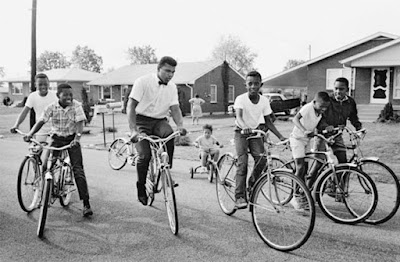According to bike lore, Gary Fisher, Joe Breeze and their buddies bombed down Marin county fire trails on pre-war Schwinn baloon-tire bikes they bought for five dollars at local thrift shops. Their experiences with those machines led them to develop the rigs we now call "mountain bikes".
Now, I wasn't there to see the runs down Sonoma hills. But I can attest to the five-dollar baloon-tire bombers. Around that time, I saw bikes like those--and others--in thrift stores. Sometimes they cost even less than what Fisher and Breeze paid. Or people would give them away when they moved or cleaned out basements or garages.
You see, in those days--the mid-1970s--the concept of "retro" didn't exist. Old stuff was, well, old stuff. Going to a thrift shop wasn't cool: You did it because you were poor or "not with it". Old baloon tire bikes were relics thought to be unsuited to the "Bike Boom", which prized ten-speeds, of whatever quality, above all else.
Fast-forward four decades. If you can find one of those old Schwinns--or even a Columbia or Murray of that era--call your credit card company and request a spending limit increase before you bid on it.
And what of those bike-boom era ten-speeds? Well, you might luck into one without paying for it if you know someone who's moving in or out and has to clear out a basement, garage, barn, shed or other storage space. But, it seems, the days of buying one with the loose change you found in your couch cushions are over.
This Peugeot---I'm guessing it's a UO8--looks like it was just pulled out of the East River. I mean, when a plastic Simplex derailleur looks almost as rusty as the chain, you know the bike hasn't been kept in a climate-controlled environment.
How much is that bike-eee in the window? Well, if you have to ask....Seriously, it had a price tag: $125.
Now, I know that's not high for a used bike these days. But if you have any intention of riding the bike, you'd probably have to spend as much, or even more, to refurbish it.
That price, by the way, is more than what the bike originally cost: about 90 dollars, back around 1970. I know the bike is from around that year because of certain details (I've seen lots of Peugeots) and because of the faded dealer sticker from Carl Hart Bicycles of 1120 Cortelyou Road, Brooklyn, NY, with a telephone number that had letters rather than numbers for its first two digits!
Given the other stuff that's in the shop, I suspect that if anyone who might buy that Peugeot isn't going to ride it. Instead, he or she will use it for "wall art" in a coffee shop or bar or some such place. Then, when the vogue for such decor dies out, where will the bike end up? (That was a rhetorical question: You know the answer!)
Now, I wasn't there to see the runs down Sonoma hills. But I can attest to the five-dollar baloon-tire bombers. Around that time, I saw bikes like those--and others--in thrift stores. Sometimes they cost even less than what Fisher and Breeze paid. Or people would give them away when they moved or cleaned out basements or garages.
You see, in those days--the mid-1970s--the concept of "retro" didn't exist. Old stuff was, well, old stuff. Going to a thrift shop wasn't cool: You did it because you were poor or "not with it". Old baloon tire bikes were relics thought to be unsuited to the "Bike Boom", which prized ten-speeds, of whatever quality, above all else.
Fast-forward four decades. If you can find one of those old Schwinns--or even a Columbia or Murray of that era--call your credit card company and request a spending limit increase before you bid on it.
And what of those bike-boom era ten-speeds? Well, you might luck into one without paying for it if you know someone who's moving in or out and has to clear out a basement, garage, barn, shed or other storage space. But, it seems, the days of buying one with the loose change you found in your couch cushions are over.
This Peugeot---I'm guessing it's a UO8--looks like it was just pulled out of the East River. I mean, when a plastic Simplex derailleur looks almost as rusty as the chain, you know the bike hasn't been kept in a climate-controlled environment.
How much is that bike-eee in the window? Well, if you have to ask....Seriously, it had a price tag: $125.
Now, I know that's not high for a used bike these days. But if you have any intention of riding the bike, you'd probably have to spend as much, or even more, to refurbish it.
That price, by the way, is more than what the bike originally cost: about 90 dollars, back around 1970. I know the bike is from around that year because of certain details (I've seen lots of Peugeots) and because of the faded dealer sticker from Carl Hart Bicycles of 1120 Cortelyou Road, Brooklyn, NY, with a telephone number that had letters rather than numbers for its first two digits!
Given the other stuff that's in the shop, I suspect that if anyone who might buy that Peugeot isn't going to ride it. Instead, he or she will use it for "wall art" in a coffee shop or bar or some such place. Then, when the vogue for such decor dies out, where will the bike end up? (That was a rhetorical question: You know the answer!)

































